Thursday 23 January 2017
White: C. Oram (110) - Black: K. Nevols (134)
Another visit to Cranbrook Library, which is becoming one of my favourite places to play chess.
1. d4 Nf6
2. Bf4
White plays a system unfamiliar to me, so I just develop normally.
2. ..... d6
3. e3 g6
4. c3 Bg7
5. Bd3
Well, I have no idea what White is doing now. He has set up his pawns on black squares and delayed development of the knights. I decided to exploit the fact that his black-squared bishop is now cut off from the defence of his queenside.
5. .... c6
6. Ne2 Qb6
The threat to the b-pawn is a bluff. If, for example, 7. Nd2 Qxb2?? then 8. Nc4 wins the queen (8. ... Qb5 9. Nxd6+).
7. b3 c5
Continuing development by preparing the develop the knight.
8. O-O Nc6
9. a4
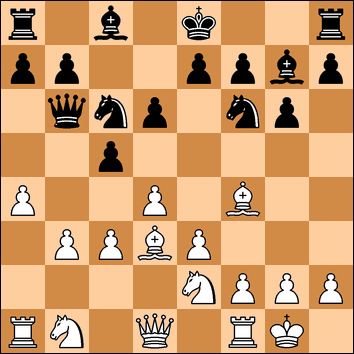
I did not understand this move which weakens the queenside, especially the b3 point, and I could only guess it was to plan Bb5. Now Black could play 9. ... e5 grabbing the initiative. For example, either 10. dxe5 dxe5 11. Bg3 O-O with Be6 to come, or 10. Bg5 O-O 11. dxc5 dxc5 12. Nd2 Be6.
Instead I just decide to continue to develop and find good squares for the pieces.
9. ... O-O
10. Nd2 cxd4
11. exd4 Bg4
The idea of this move is just to create a weakness. The computer in the last few moves still prefers breaking in the centre with e5.
12. f3?!
Weakening the e3 square and the diagonal towards the king. A better move would have been 12. h3.
12. .... Be6
Unlike the computer, I refer to place the bishop on e6 in front of the e-pawn. If one notices the weaknesses on e3 and c3 then the move Nd5 speaks for itself - so White should now consider 13. Nc4 Qc7 14. Bd2 and the position is equal.
13. Rb1
Again a move I did not quite understand, so I carry on probing.
13. .... Nd5
14. Nc4 Qd8
Playing 14. .. Qc7 was more accurate as here the queen blocks the rooks, but I was concerned about placing the queen on the same diagonal as the bishop. There was probably no need to worry as 15. Bg3 walks into the same tactic we are about to see whereas 15. Bd2 or 15. Ne3 Nxf4 would have removed the bishop from the diagonal.
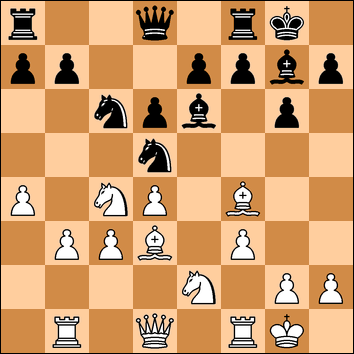
Now White must play 15. Bd2 and I am not sure how I would have continued, 15. .. a6 maybe, but instead ...
15. Bg3??
A blunder that loses two pawns.
15. .... Nxc3
16. Nxc3 Bxd4+
17. Bf2 Bxc3
So out of nowhere I am suddenly two pawns up and have a passed d-pawn. My next task was to consolidate as I anticipated White, with his two bishops and knight, would now try to stir up some activity.
18. Qc2 Bf6
I preferred this slightly more active spot to Bg7 which also defends the e7 pawn.
19. Rfd1?
Another mistake. White should have played 19. b4. Now I force the win of more material.
19. ... Nb4
20. Qe2 Nxd3
21. Rxd3 Bf5
22. Rbd1 Bxd3
23. Rxd3
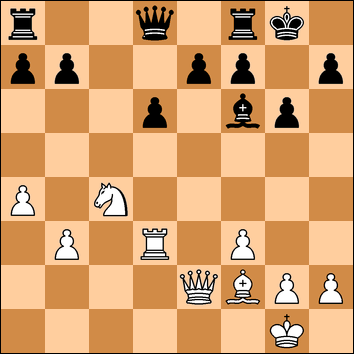
So now I am an exchange and two pawns ahead. White now aims for counterplay by attacking down the centre files.
23. ... Qd7
24. Ne3 Rfc8
25. g3
Making some space along the bank rank. The moves I was keeping an eye on was Nd5 and then Re3. Here though Black should play 25. ... Rc1+ 26. Kg2 R8c8
25. ... Qe6
26. Qd2 Bg5
27. f4 Bh6
The intention here is to relocate the bishop to f8 - a passive but defensive spot out of the range of a knight on d5. (28. Nd5 Qd7 29. Re3 Bf8 30. Qe1 Re8 31. Rc3 - planning Nc7 - Rac8 32. Bxa7 Rxc3 33. Nxc3 Bg7 - White gives up a pawn to get a set of rooks off).
28. Nc4 Rc7
Doubling up - although Black might get away with 28. .. Rxc4 29. bxc4 Qxc4 entering an ending where he is three pawns up.
29. Ne3
A change of mind. 29. Qa5 is more active and exploits the brief un-coordination in the black ranks, although 29. .. b6 is possible because of 30. Bxb6 Rxc4! 31. bxc4 Qe4 32. Re3 Qb1+ and Qxb6 or 30. Nxb6 Rc1+ 31. Kg2 Qe4+ and axb6.
29. .... Rac8
30. Nd5 Rc1+
31. Kg2 Qe4+
32. Kh3 R1c2
An improvement was 32. .. Bf8! defending the e-pawn so that Black can think about Qh1.
White now forces the queens off and gets a pawn back.
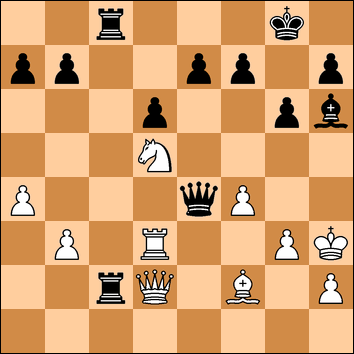
33. Qe3 Qxe3
34. Bxe3 Kf8
35. Bxa7
White now has a pawn majority on the queenside as his card to play.
35. ... Bg7
36. Nb6 R8c3
37. Rxc3 Rxc3
38. b4 Ke8
I've got to get the king in that direction to avoid any accidents.
39. Nd5 Rc4
40. a5 e6
Winning a pawn.
41. Nb6 Rxb4
42. Na8
I remembered a previous game of mine where the knight ended up in the corner (Game 10). Now Black can win the a-pawn with 42. ... Ra4 and Bc3.
42. ... Kd7
43. Nb6+ Kd8
44. Na8 Bd4
45. Bb8 d5
46. Bc7+ Kd7
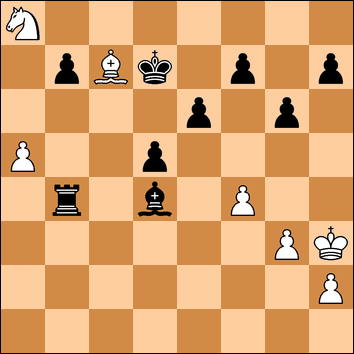
At this stage, all the other games had finished. White is running out of moves and so decided to resign.
As the other games had ended in draws, I was pleased to win the match for the team, but I have to admit that the queenside play towards the end did concern me.
Weald of Kent v Swale
Clive Oram (112) 0-1 Keith Nevols (134)
David Warrick (108) 1/2-1/2 Tyrone Jefferies (116)
Mark Homer (107) 1/2-1/2 Andrew Gillard (113)
Alex Garfield (111) 1/2-1/2 Anthony Fletcher (74)
Weald of Kent 1.5-2.5 Swale
No comments:
Post a Comment